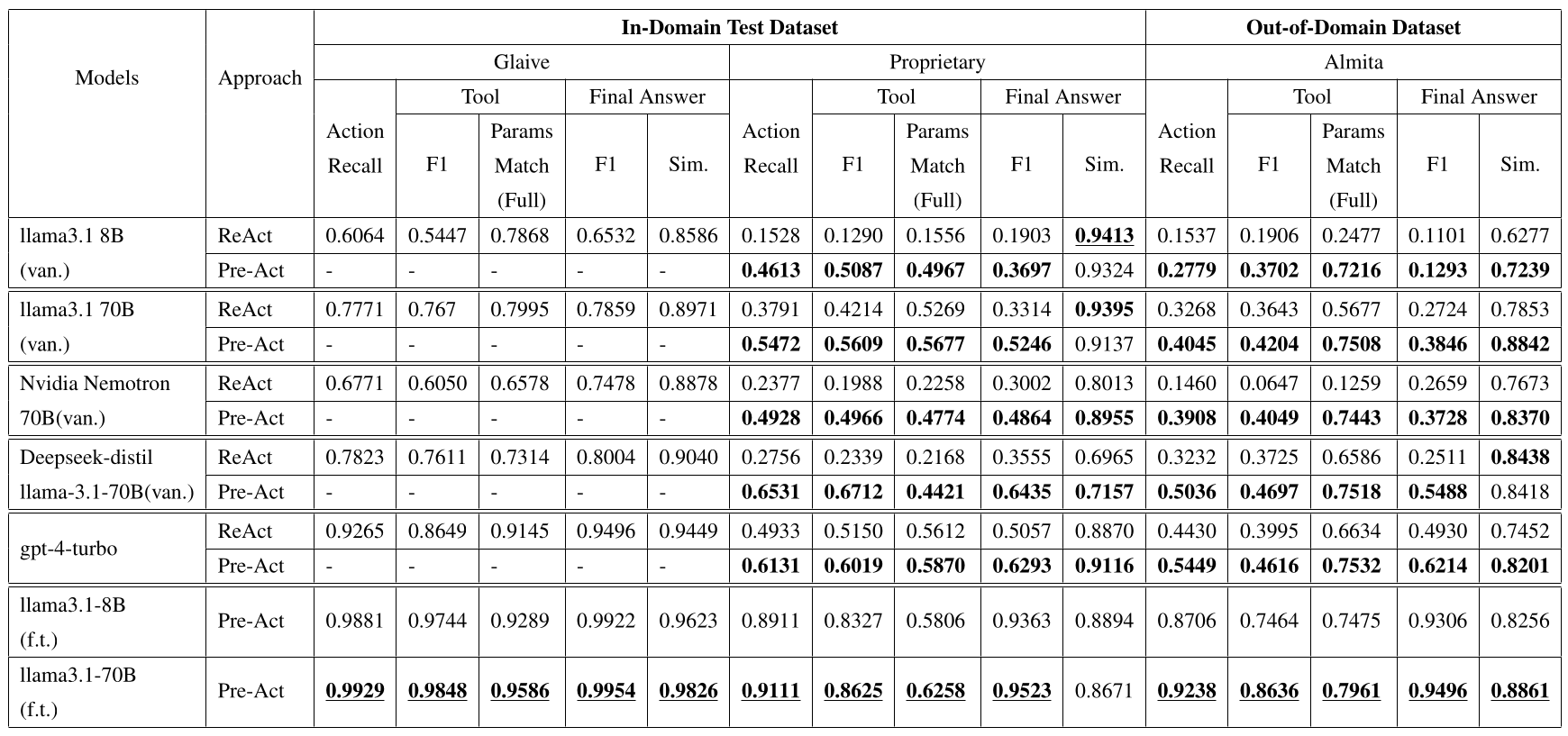[論文介紹] Pre-Act: Multi-Step Planning and Reasoning Improves Acting in LLM Agents

1 前言
本篇文章介紹 Pre-Act: Multi-Step Planning and Reasoning Improves Acting in LLM Agents 論文,由 Uniphore 公司於 2025 年 5 月發表於 arXiv。
2 Pre-Act 想解決的問題
在 ReAct 方法中,LLM 的 (Single-Step) Reasoning (Thinking) 都只是針對下一個 Action,而不是針對未來一系列的 Action,這樣的 Reasoning 方式導致 ReAct 在需要 Long-Term Planning 的任務上表現不好。
3 Pre-Act 提出的解決方法
讓 LLM 每一次的 Thinking 都可以產生一個詳細的 Plan。這個 Plan 主要包含,“過去已經執行的步驟” 與 “接下來要執行的步驟”。
舉例來說,基於一個 Input Task,Pre-Act 在第一次 Thinking 時,會產生一個包含 N 個步驟的 Plan,每一個步驟都會敘述要進行什麼 Action (其實就是使用什麼 Tool),然後最後一個步驟就是使用 “Final Answer” Tool 來輸出最終答案。在每次 Thinking 結束後,Pre-Act 會輸出一個 Action (透過 JSON 表示),系統會執行這個 Action 並將 Observation 放回到 Context 中。
接著,Pre-Act 在進行第二次 Thinking 時,會根據 Context 中的內容 (前一次的 Plan, Action 與 Observation),重新產生一個 Plan。新的 Plan 中會描述過去幾次的 Thinking 與 Action 已經完成了什麼,並根據此修改接下來要完成的步驟。

如上圖的範例,可以清楚看到 ReAct 的每一次 Thinking 就是僅僅針對接下來馬上要採取的 Action,而 Pre-Act 的每一次 Thinking 都會有一個 Global Plan 的描述。
Pre-Act 透過以下 (論文提供的) System Prompt 的設計幫助 LLM 做到上述的 Reasoning 流程:(但老實說我覺得 System Prompt 寫的相當凌亂)
<system> You are an intelligent assistant and your task is to respond to the human as helpfully and
accurately as possible. You would be provided with a conversation (along with some steps if present)
and you need to provide your response as Final Answer or use the following tools (if required):
Instructions:
------------------------------------------------------------------------------------------
{instructions}
Functions/Tools:
------------------------------------------------------------------------------------------
{tools}
===============
Use a json blob to specify a tool by providing an action key (tool name) and an action_input key
(tool input).
Valid "action" values: "Final Answer" or {tool_names}
In case of final answer:
Next Steps (Plan):
1. I will now proceed with the final answer because ... (explanation)
Follow this format (flow):
Question: input question to answer
Thought: consider previous and subsequent steps and conversation. Summary for what you did previously (ONLY IF
function calls were made for the last user request) and create the multi-step plan.
Action:
```
$JSON_BLOB
```
Observation: action result
... (repeat Thought/Action/Observation N times)
Thought: First provide the summary of previous steps (ONLY IF function calls were made for the last user request)
and then the plan consisting of only 1 step i.e. proceed with the final answer because ... explanation for it
Action:```
{
"action": "Final Answer",
"action_input": "Final response to human”
}
Definition of Multi-Step Plan:
For each request you will create a multi-step plan consisting of actions that needs to be taken until the final
answer along with the reasoning for the immediate action.
E.g.
Next Steps (Plan):
1. I will first do ... (action1) with the detailed reasoning.
2. I will do ... (action2) with the detailed reasoning.
k. I will do ... (actionk) with the detailed reasoning.
k+1. I will now proceed with the final answer because ... (explanation)
Example Output: When responding to human, please output a response only in one of two formats
(strictly follow it):
**Option 1:**
If function calls were made for the last human message in the conversation request, include Previous Steps: ... +
Next Steps: multi-step plan (provide an explanation or detailed reasoning)." Otherwise, provide Previous Steps:
NA and Next Steps: ..
Action:
```
{
"action": "string, \ The action to take. Must be one of {tool_names}",
"action_input": dict of parameters of the tool predicted
}
```
**Option #2:**
In case of you know the final answer or feel you need to respond to the user for clarification,
etc. Output = Thought: If function calls were made for the last human message in the conversation
request, include Previous Steps: ... + Next Steps: Let's proceed with the final answer because ...
(provide an explanation)." Otherwise, provide Previous Steps: NA and Next Steps: ..
Action:
```
{
"action": "Final Answer",
"action_input": "string \ You should put what you want to return to use here"
}
```
Begin! Reminder to ALWAYS respond with a valid json blob of a single action. Use tools if necessary
and parameters values for the tool should be deduced from the conversation directly or indirectly.
Respond directly if appropriate. Format is Thought:\nAction:```$JSON_BLOB```then Observation <user>
Conversation:
{conversation}在 Pre-Act 論文中也有針對 Llama-3.1-8B 與 Llama-3.1-70B 進行 Finetune,訓練模型輸出 Pre-Act 風格的 Thinking 方式。有興趣的讀者可以再閱讀原始論文,這邊就不贅述!
4 Pre-Act 實驗結果

上述實驗結果來自論文中的 Table 2,是 Pre-Act 的主要實驗。上表中的前 5 列代表未經過 Finetune 模型 (“van” 表示 “vanilla”),只有透過不同 System Prompt 來比較 ReAct 與 PreAct 的表現。而最後 2 列則是有經過 Finetune 模型的表現 (“f.t.” 表示 “finetune”)。
從兩種實驗設定下可以觀察到:
- 模型只有透過修改 System Prompt 來達到 Pre-Act-Based 的 Reasoning 表現也比 ReAct-Based 勝過許多
- 模型若特別 Finetune 在 Pre-Act-Based 的 Reasoning 方式,表現又可以比僅修改 System Prompt 的方法好上更多
5 結語
本篇文章非常快速的介紹了 Pre-Act: Multi-Step Planning and Reasoning Improves Acting in LLM Agents 論文:
Pre-Act 中透過每一個 Reasoning Step 來產生以及修改 Plan,來優化傳統的 ReAct-Based Reasoning 中僅針對馬上要執行的下一個 Action 的 Single-Step Thinking 的不足,讓 LLM 在 Long-Term Planning 的任務上有更好的表現。
比較可惜的是,論文中比較的 Baseline 僅有針對 ReAct 一種方法,所使用的 Public Benchmark 也僅有一種。然而,由於 ReAct 也可以算是 LLM Agent 領域的始祖等級的論文,後續也還有許多方法被提出,再加上 Benchmark 較少,比較難說明 Pre-Act 方法能夠多有效。但透過本篇論文,我們還是得以知道 “產生 Plan” 以及 “修改 Plan” 在 LLM 處理任務上所帶來的好處!